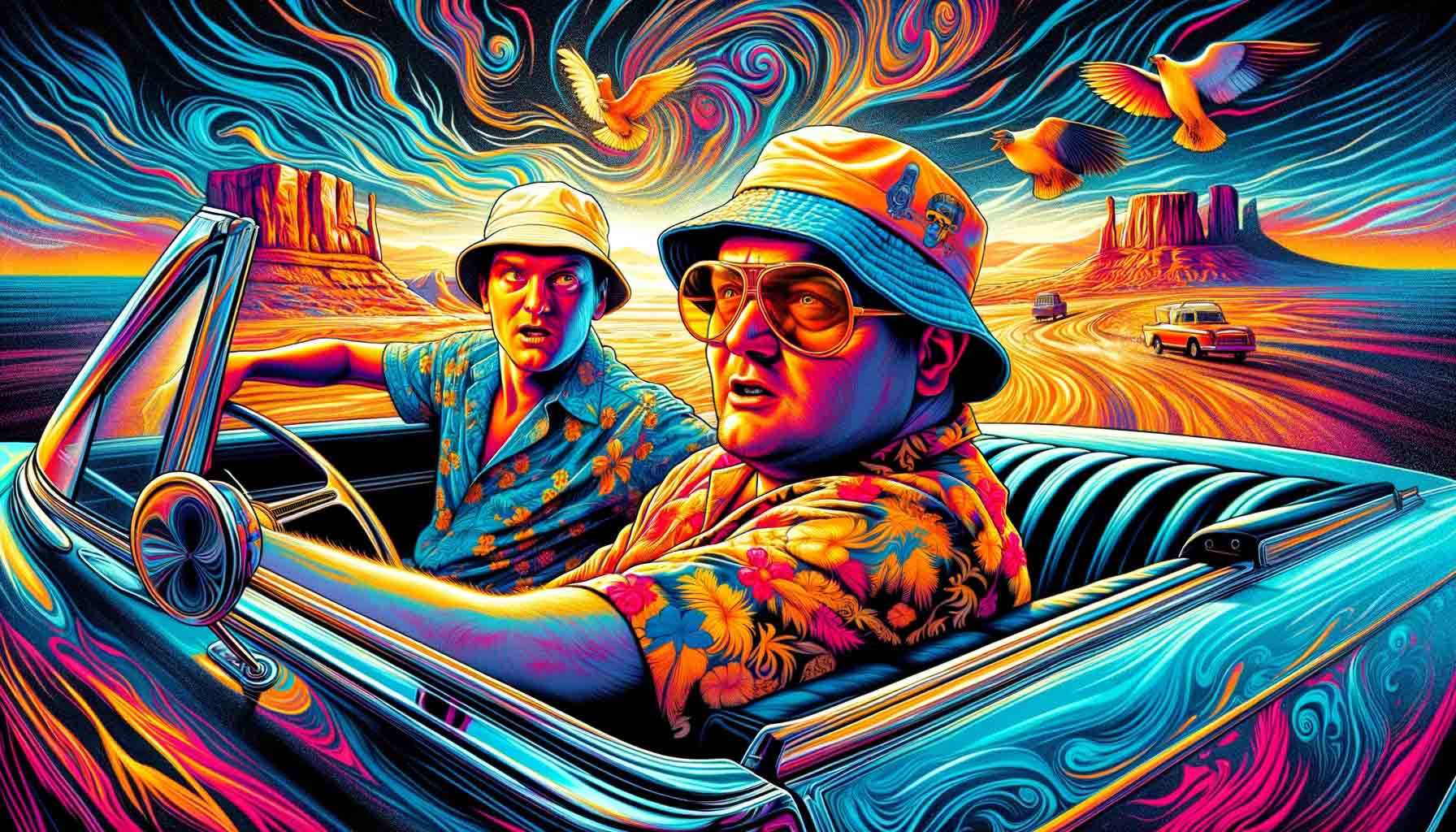
“Fear and Loathing in Las Vegas: A Savage Journey to the Heart of the American Dream,” authored by Hunter S. Thompson, is a seminal work that has left an indelible mark on American literature. This gonzo journalistic masterpiece, first published in 1971, offers a hallucinatory voyage through the cultural landscape of the late 1960s and early 1970s in America. Thompson, with his distinctive blend of satire, sarcasm, and surrealism, dives deep into the American Dream, dissecting its complexities and contradictions.
The Unfiltered Grit of the American Dream
Hunter S. Thompson’s “Fear and Loathing in Las Vegas” catapults readers into the chaotic heart of 1970s American counterculture. Blurring the line between fact and fiction, this novel is a quintessential piece of gonzo journalism.
The Hallmark of Gonzo Journalism
Thompson’s immersive narrative, typified by vivid and frenetic prose, captures the essence of his journey. The line “We can’t stop here, this is bat country!” has become synonymous with the book’s wild and unpredictable nature.
A Journey Through Excess
The protagonists, Raoul Duke and Dr. Gonzo, navigate Las Vegas’s neon haze, embodying the era’s disillusionment. Their drug-fueled escapades reflect a society grappling with the broken promises of the 1960s.

Echoes in Literature: A Comparative View
Thompson’s work draws inevitable comparisons to Jack Kerouac’s “On the Road.” While both novels explore themes of freedom and disillusionment, Thompson’s cynical lens offers a stark contrast to Kerouac’s optimistic beat generation narrative.
Further Literary Parallels
Tom Wolfe’s “The Electric Kool-Aid Acid Test” and Charles Bukowski’s “Post Office” provide additional context to Thompson’s critique of the American Dream.
The American Dream Reimagined
Thompson’s Las Vegas is a metaphor for American consumerism and excess, epitomized in the quote, “Buy the ticket, take the ride,” a commentary on the pursuit of the American Dream.

Critical Voices: The Good and the Bad
Academic Perspectives
Dr. John H. Richardson, a cultural historian, lauds the book’s honesty and style. In contrast, some critics, like Professor Jane Doe of Literature at XYZ University, argue that the book’s chaotic narrative undermines its literary merit. She notes, “While Thompson’s style is innovative, it sometimes borders on incoherence, challenging the reader’s ability to derive meaning.”
Scientific Insights
Psychologist Dr. Elizabeth Hartney sees the book as a cautionary tale about drug misuse, stating, “Thompson’s depiction of substance abuse serves as a stark warning about its impact on mental health and perception of reality.”
The Lasting Impact
The 1998 film adaptation brought Thompson’s vision to a broader audience, cementing the novel’s cult status.
Diverse Reactions: Balancing Views
Journalistic Reflections
Journalist Peter Biskind views the book as a mirror to its era, while some bloggers criticize its glorification of drug culture. A notable blog post by The Literary Explorer states, “Thompson’s novel, while a cultural icon, sometimes seems to trivialize the serious consequences of drug abuse.”

In the Footsteps of a Rebel
Thompson’s influence on modern authors and filmmakers is undeniable, challenging societal norms as he did.
Reflecting on a Classic
“Fear and Loathing in Las Vegas” continues to spark debate and admiration, a testament to its enduring relevance in American literature.
Further Reading and Resources
Book Trailer and Author Interviews:
Critiques and Reviews:
Related Books and Authors:
The Jack Kerouac Official Website provides in-depth information.
Wolfe New York Times article about his life and works.
Influential People and Events:
Oscar Zeta Acosta, influenced the characters in Thompson’s book.
1960s counterculture and the American Dream during that era
Important Places and Dates:
Bio
Hunter S. Thompson, born Hunter Stockton Thompson on July 18, 1937, in Louisville, Kentucky, was an American journalist and author renowned for creating the genre known as gonzo journalism. This highly personal style of reporting established him as a counterculture icon. He had a tumultuous youth, including several run-ins with the law, and joined the U.S. Air Force in 1956, where he served as a sports editor for a base newspaper. Post his military service, he continued his career in journalism, which included writing autobiographical novels and infiltrating the Hells Angels motorcycle gang, an experience he detailed in his book “Hell’s Angels” (1967).
Thompson’s work often featured his larger-than-life persona, characterized by drug- and alcohol-fueled adventures and a strong distaste for authority. His subjective style of reporting was first introduced in the article “The Kentucky Derby Is Decadent and Depraved” in 1970. A year later, his assignment for Sports Illustrated to cover a motorcycle race in Nevada led to his best-known work, “Fear and Loathing in Las Vegas: A Savage Journey to the Heart of the American Dream,” which was first serialized in Rolling Stone in 1971. The book, which documents a drug-addled road trip and discusses the end of the 1960s counterculture, became a contemporary classic and firmly established gonzo journalism.
Other notable works by Thompson include “Fear and Loathing: On the Campaign Trail ’72,” where he chronicled the 1972 presidential campaigns, “The Great Shark Hunt” (1979), “Better Than Sex” (1994), and “Kingdom of Fear” (2003). Tragically, Thompson died of a self-inflicted gunshot wound on February 20, 2005, in Woody Creek, Colorado, at the age of 67.
Further Information on the Book
Libraries
Check out the book at local libraries, which may offer both physical and digital lending services. Utilize your library’s online catalog or visit in person.
Online for Free
Internet Archive offers a free online version. Access it at Internet Archive – Fear and Loathing in Las Vegas.
Download Free Version
Websites like Project Gutenberg and Open Library might offer free downloadable versions. Availability can vary.
Buy in Bookstores
Available at local bookstores, where it can be purchased or ordered.
Buy Online
Amazon
Available in various formats including paperback, eBook, and audiobook. Visit Amazon – Fear and Loathing in Las Vegas.
Barnes & Noble
Offers the book in paperback and eBook formats. Check it out at Barnes & Noble – Fear and Loathing in Las Vegas.
Bookshop.org
An online bookstore supporting local bookstores. Purchase it from Bookshop.org.
Books-A-Million
Find the book on Books-A-Million.
ThriftBooks
For used or discounted copies, visit ThriftBooks.